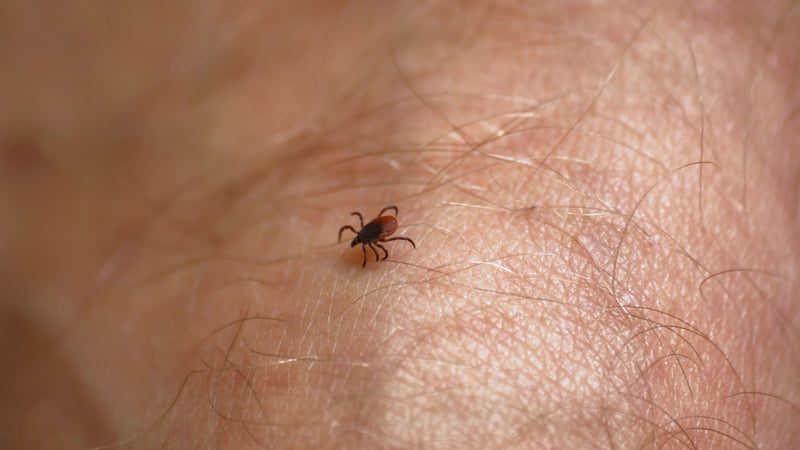 No one wants to find a bug in their home. It's not the most fun thing to look over and see a spider or ant watching your shows with you. But there are some pests you really do not want to find in the safe space of your house, and one of those is a tick. Despite their tiny size, ticks can be a serious nuisance. Their bites result in discomfort and irritation, but ticks can also potentially transmit serious diseases to both animals and humans. That's why it's important to know how to identify ticks, prevent them from getting into your home and understand how to get rid of them if they do make it into your house. Read on for advice from the pros at MosquitoNix® in our Pest Library.
No one wants to find a bug in their home. It's not the most fun thing to look over and see a spider or ant watching your shows with you. But there are some pests you really do not want to find in the safe space of your house, and one of those is a tick. Despite their tiny size, ticks can be a serious nuisance. Their bites result in discomfort and irritation, but ticks can also potentially transmit serious diseases to both animals and humans. That's why it's important to know how to identify ticks, prevent them from getting into your home and understand how to get rid of them if they do make it into your house. Read on for advice from the pros at MosquitoNix® in our Pest Library.
Description of a Tick
Ticks are quite small compared to other common bugs, which causes problems. At their largest, they are often no larger than 1 centimeter long, and tick larvae can be less than 1 millimeter in size. That makes them hard to spot before they're on you and still hard to see if they do manage to latch on to a human or pet. Ticks can also vary in color according to their species, but the most common types of ticks in the U.S. are typically dark brown or reddish. After a blood meal, a tick will become engorged and the body will take on a grey color.
They have eight legs at the adult stage, making them arachnids and not insects, and their bodies are oval-shaped. Ticks feed on blood from mammals, reptiles and birds. Unlike other insects like mosquitoes that feed quickly from a host, a tick might feed over the course of several days, becoming engorged with blood.
During this feeding time, a tick that is carrying a disease can transmit it to the host, whether that is an animal or a human. The most common disease transmitted by ticks is Lyme disease, but there are quite a few viruses and illnesses a tick can transmit to a host. In order to do so, a tick must be attached for at least 24 hours, and some species need up to 48 hours to transmit the disease.
Ticks cannot fly or jump, but they sense potential hosts through body heat, body odor, breath, vibrations, moisture and shadows. They wait along pathways, gripping vegetation with their hindmost legs with the front legs outreached. Once a potential host comes near, they simply climb aboard and look for a good area of skin on which to feed. It can be that simple and easy for a tick to grab ahold of you, which is why knowing how to get them out of your house-and keep them out-is important for every person to understand.

Breeding Habits
Female ticks lay eggs after they've fully matured to adulthood, which takes about two years, depending on the species. They don't lay eggs on their hosts, as they need to detach in order to mate, but they'll lay them anywhere else, including in your carpets, clothes or furnishings. One female can lay thousands of eggs, and upon hatching, ticks require a blood meal to survive through each of their stages: which are larva, nymph and adult. At the larva stage, ticks have six legs, but they develop eight legs by adulthood. Ticks generally prefer a new host for each meal, and many perish without completing the lifecycle because they cannot find a host. A successful tick has a full lifecycle of about three years, but each species has a different life cycle, and that also varies depending on whether the tick is a male or a female.
Geography
There are hundreds of species of tick, and they are found on every continent, including Antarctica. Ticks tend to live in moist, heavily vegetated and wooded areas. Compost piles, leaf piles and overgrown parts of your yard are all common areas to find ticks. From parks to dog parks to sidewalks to tall grass-ticks can hang out in the most basic places anyone could easily walk by.
Some species are only found in the Eastern part of the United States, while others prefer Northern Asia. To understand how to keep a tick out of your home, you need to look up which are the common ticks in your area. This will also give you a better understanding of where you could encounter them in your day-to-day life.
Solutions for Ticks Around Your Home
If you feel a tick bite or see a tick on your body or the body of your pet, it does not necessarily mean you have an infestation. When ticks are found in the home, it is usually because a single tick has been brought in on a pet, a person or a piece of clothing. For the most part, finding one tick means you only have one tick in your home.
However, in some situations, ticks will thrive in a crawl space or attic by living on suitable hosts such as rodents that have made a nest there. Most ticks do not survive or reproduce indoors on their own, though there are some exceptions, like the brown dog tick. If you find more than one, or if you find a few ticks and have seen a mouse or other rodent nearby, it could be worth it to have a professional look over those darker spaces in your home.
Treating your yard for ticks can help keep them out of your home, but prevention starts before you even leave the house. If you have pets, they should also be treated for ticks each month to protect them and keep them from bringing ticks inside. If you spend a lot of time outdoors, particularly in the woods or in heavily overgrown areas, wear long sleeves, pants and socks, and use an EPA-approved tick spray with at least 20% DEET. Also, check your clothing carefully for ticks before coming indoors to keep from bringing ticks inside.
Your yard also needs attention to prevent ticks from getting too close. Keep your grass mowed short, don't let debris or piles of stuff take over your yard and check that trees and other greenery are neat and tidy. Don't position outdoor furniture, playground equipment or other items too close to the edge of your yard, especially if you have any wooded areas close. Knowing how to get rid of ticks before they enter your home will help prevent an infestation.
If you find a tick, remove it carefully with tweezers to reduce the risk of infection. If you don't have tweezers, there are a few methods you can use to remove a tick without tweezers. Go slowly and be gentle, to not crush the body of the tick, as this may spread bacteria and disease. If you are having an adverse reaction to a bite, like getting a fever or a develop a rash, seek medical attention.
If you find more than one tick in your home, it should be cause for concern. Call our team of expert pest control specialists at MosquitoNix and we'll ensure that your home is tick-free once again. This can include both indoor and outdoor treatments on your property, long-term or short-term solutions or creating a specific plan for your situation. By reducing the number of ticks in your yard, you're less likely to have one hitch a ride into the house. Learn more by getting a quote online today.
Resources:
https://www.cdc.gov/ticks/life_cycle_and_hosts.html
https://www.medexpress.com/blog/better-health/tick-life-cycle.html
https://www.theguardian.com/science/blog/2018/jan/25/forget-ebola-sars-and-zika-ticks-are-the-next-global-health-threat




